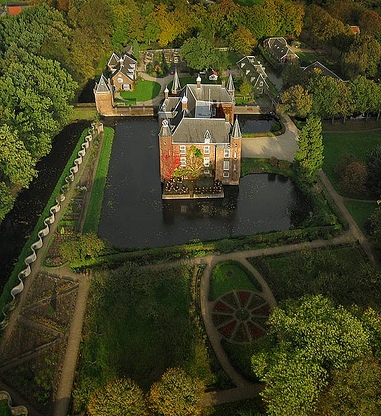

Location: Tournooiveld 1, Oud- Zuilen, Vechtstreek Map
Constructed: current castle is constructed in 1525
Tel. 030 244
0255
Open:
15 Mar- 15 May & 15 Sept- 15 Nov: Sat & Sun (groups by
appoint)
15 May- 15 Sept: Tue- Thu, Sat & Sun
Closed: 15 Nov- 15
Mar
The Castle of Zuylen, usually Slot Zuylen, is a castle in
Ald-Zuilen, on the river Fecht in the municipality of Stichtske
Fecht, in the province of Utrecht, near the city of Utrecht. The
castle was built in the 13th century.
In the 13th century,
Mr. Van Sulens, ancestor of the Van Zuylen van Nijevelt family, had
a tower built, which was expanded with a large room in the 14th
century. In the beginning of the 15th century, when the layer Van
Zuylen had no male heirs, it was given to the hands of Van Borssele,
a family of high nobility from Zeeland. Frank van Borselen inherited
it in 1422, but did not benefit much from it: in that year, as part
of the Tierderijen van Hoeken and Kabbeljauwen, the Hoeksken took
the castle.
Between 1510 and 1522 Mr. Willem van Rennenberg
had the castle restored. The owner of the castle gets a permanent
seat in the council of the Principality of Utrecht. His descendants,
including George van Lalaing and the house of Egmont, became the
owner until 1610, when the castle was sold to a rich merchant from
Amsterdam, Jasper Quinget. Six years later, he sold the castle to
his colleague Adam van Lockhorst.
In the 13th century, a donjon was built by the Lords
of Suilen and Anholt. Not much is known about this residential tower.
In the 14th century, the keep was expanded with a hall house. The
Van Zuylen family divided into several branches: the Van Zuylen family
remained ruler of the castle until the 14th century. In 1422 Frank van
Borssele inherited the castle by marriage. In that same year, during the
Hoekse and Kabeljauwse quarrels, the castle was razed to the ground by
the Utrechtse Hoeken.
It was not until 1510 that the rebuilding
of Slot Zuylen was started by the nobleman Willem van Rennenberg.
Shortly after its inauguration, it was recognized as a knight's court
town. His descendants, including George van Lalaing, and the Egmond
family owned it until it was sold in 1611 to the Amsterdam merchant
Jasper Quinget. His fellow townsman Adam van Lockhorst became the next
owner six years later. Around 1620, Admiral Steven van der Hagen lived
in the castle. Finally, in 1656, the castle came into the possession of
the Van Tuyll van Serooskerken family by inheritance. Because of their
contacts Slot Zuylen remained unaffected in the Disaster Year 1672.
The snake wall of 120 meters was built in 1742. The castle was last
extensively renovated in 1751-1752. The castle was given a U-shape: the
retaining wall was demolished and the accompanying moat filled in,
turning the courtyard into a forecourt. To achieve a symmetrical whole,
a left wing was added. An extra outer wall was built so that a porch was
created at the new entrance door with new stairs, so that the rooms
could be reached separately. No major changes have been made to the main
building since then.
From 1803-1808 Slot Zuylen was rented out by
Willem René van Tuyll van Serooskerken for economic reasons.
In
the early 1950s, Frederik Christiaan Constantijn van Tuyll van
Serooskerken placed the castle with the gardens in a foundation. Several
restorations subsequently took place at Slot Zuylen. Today it also
functions as a museum.
One of the most famous residents of the
castle was the writer Belle van Zuylen (1740-1805).
The castle is located in a small park of 1.5 hectares with a 120
meter long snake wall. The castle also has canals with the following
separate national monuments: quay walls, a culvert, bridge,
gatehouse, corner tower, coach house, gardener's house, castle farm,
wood storage and wagon shed, playhouse, iron fencing and a vegetable
garden.
Between the castle and the Vecht is a church that was
rebuilt after a fire in 1848. The church is a national monument and
a chapel used to be here. Under the church floor is a tombstone of
Willem van Rennenberg. About half a kilometer from the castle is the
Oud-Zuilen cemetery, which functions as a burial place for the Van
Tuyll van Serooskerken family, among other things.
The castle has a tapestry by the Delft tapestry weaver Maximiliaan
van der Gught.
The oldest known furniture made by Gerrit Rietveld
dates from 1906 and was intended for the gatehouse.
The 18th century
serpent wall ends at the level of the gatehouse in a bulwark with
shooting slits. This defense element is considered a folly.
The TROS
children's series Koning Bolo was filmed in Slot Zuylen.